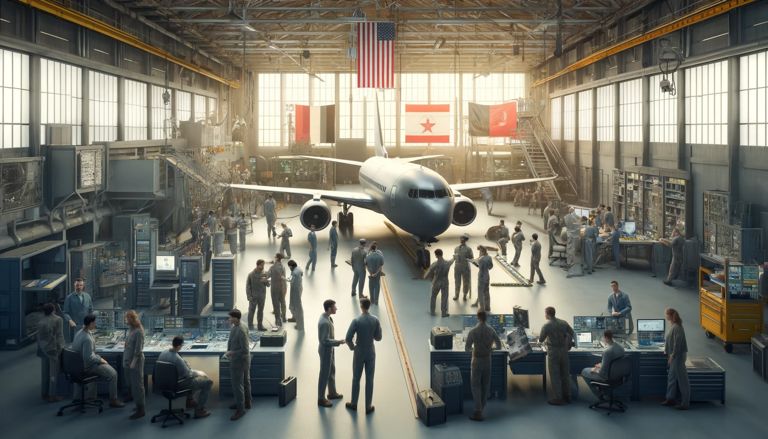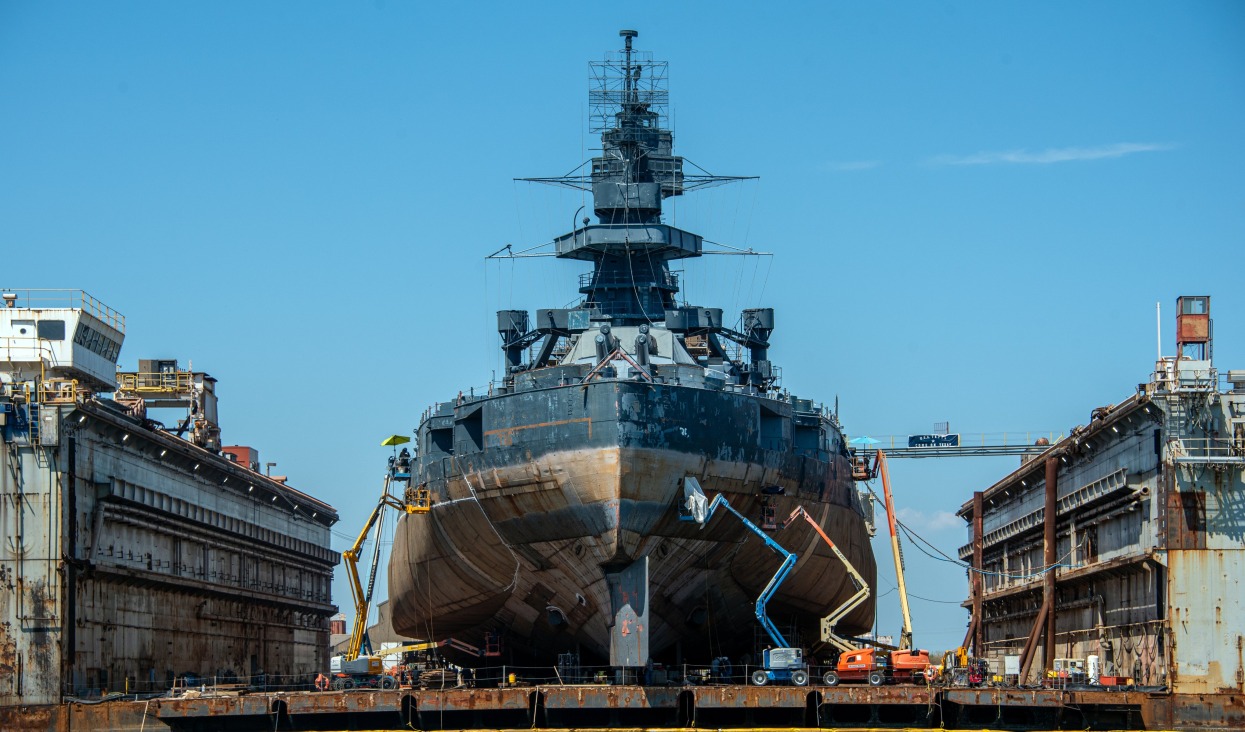American warplanes are serviced and repaired in Japan and South Korea for faster turnaround time. The US is looking at Indio-Pacific nations, including India, where its warships can be quickly serviced and put back into action. Upgrading servicing capabilities for US military assets comes amid heightened military threats from China.
The global military Maintenance, Repair, and Overhaul (MRO) market is witnessing significant growth, driven by technological advancements, increased defense spending, and the rising demand for operational readiness.
The MRO market, integral to sustaining and extending the life of military assets, is poised to play a crucial role in shaping the future of military operations.
However, this market’s complexity, underscored by the multinational nature of military aviation components, presents unique challenges and opportunities. This piece delves into the current trends in the military MRO market, its impact on future military operations, and the inherent complexities of a globally interconnected supply chain.
Market Size & Trends
The military MRO market has been expanding steadily, with recent reports estimating its value at approximately USD 81.6 billion in 2023. Projections indicate a compound annual growth rate (CAGR) of around 4.1%, which will likely push the market size to over USD 100 billion by 2028. This growth is fueled by several key factors:
- Technological Advancements: The incorporation of advanced technologies such as Artificial Intelligence (AI), the Internet of Things (IoT), and predictive maintenance tools is revolutionizing MRO activities. These technologies enhance the efficiency and accuracy of maintenance operations, reducing downtime and costs.
- Increased Defense Spending: Many countries are ramping up their defense budgets to modernize their military capabilities. This increase in funding is directed not only towards new acquisitions but also towards maintaining and upgrading existing fleets.
- Operational Readiness: With rising geopolitical tensions, there is an emphasis on ensuring that military assets are combat-ready at all times. Regular maintenance and timely overhauls are critical to achieving this state of readiness.
- Aging Fleet: Many military aircraft are approaching or have surpassed their expected service life. Extending the operational life of these assets through MRO activities is a cost-effective alternative to new purchases. These trends highlight the importance of the MRO market in sustaining military operations and ensuring that armed forces are equipped to respond promptly to emerging threats.
Impact On Future Military Operations
The evolving MRO market is set to have profound implications for future military operations. Key impacts include:
1. Enhanced Operational Efficiency: Advanced MRO practices reduce the time aircraft and other military assets spend out of service. This means higher availability rates and more efficient use of resources, leading to improved operational readiness and responsiveness.
- Cost Savings: Armed forces can leverage predictive maintenance and AI to preemptively address potential issues before they escalate into costly repairs. This proactive approach results in significant cost savings over time.
- Increased Lifespan of Military Assets: Regular maintenance and timely upgrades ensure that military equipment remains in optimal condition for longer periods, delaying the need for expensive new acquisitions.
- Interoperability and Standardization: As military operations increasingly involve coalitions of allied forces, standardized MRO practices and components become crucial. This standardization facilitates interoperability among different nations’ military equipment, enhancing the effectiveness of joint operations.
- Resilience and Adaptability: A robust MRO framework enables armed forces to quickly adapt to changing operational requirements. Whether it’s integrating new technologies or addressing emerging threats, an effective MRO strategy ensures that military assets can be swiftly reconfigured and deployed.These impacts underscore the strategic importance of the MRO market in shaping the future capabilities and effectiveness of military forces globally.
Complexity Of Multinational MRO Operations
The military MRO market’s complexity is significantly amplified by the multinational nature of modern military aviation. Today’s military aircraft are often composed of parts and components sourced from various countries, each with its own set of regulations, policies, and political alignments. This intricate web of international supply chains presents several challenges:
1. Divergent Regulations and Standards: Different countries have varying regulations and standards governing the manufacture, maintenance, and repair of military equipment. Ensuring compliance with these diverse standards is a major challenge for MRO providers operating in a multinational context.
- Geopolitical Tensions: Political and diplomatic relationships between countries can impact the availability and flow of critical components. Sanctions, trade restrictions, and export controls can disrupt supply chains, leading to delays and increased costs.
- Supply Chain Security: The reliance on international suppliers raises concerns about supply chain security. Ensuring that components are not compromised or tampered with is essential to maintaining the integrity and performance of military assets.
- Coordination and Communication: Effective communication and coordination among various stakeholders—manufacturers, MRO providers, and military operators—are crucial for the seamless execution of maintenance operations. Language barriers, cultural differences, and time zone disparities add layers of complexity to this coordination.
- Intellectual Property and Proprietary Technology: Protecting intellectual property and proprietary technology in a multinational environment is a significant concern. Ensuring that sensitive information is not leaked or misused requires stringent safeguards and protocols.

Opportunities For Collaboration & Innovation
Despite the challenges posed by the multinational nature of military MRO operations, there are significant opportunities for collaboration and innovation that can lead to more advanced and efficient maintenance solutions. By leveraging the diverse strengths, expertise, and technological advancements of different countries, the global military MRO market can enhance its capabilities in several ways:
1. Technology Transfer and Knowledge Sharing: Collaborative efforts among nations can facilitate the transfer of cutting-edge technologies and best practices in maintenance, repair, and overhaul. Knowledge-sharing initiatives, such as joint training programs, conferences, and workshops, enable military MRO providers to learn from each other and adopt the latest techniques and methodologies.
2. Joint Research and Development: Multinational partnerships in research and development (R&D) can drive innovation in the MRO sector. By pooling resources and expertise, countries can work together to develop new materials, advanced diagnostic tools, and predictive maintenance technologies that improve the efficiency and effectiveness of MRO activities.
3. Standardisation and Interoperability: Collaborative efforts to standardize MRO processes and components can enhance interoperability among allied forces. Standardization reduces the complexity of maintenance operations, simplifies supply chains, and ensures that military equipment from different countries can work seamlessly together in joint missions.
4. Economies of Scale: Multinational cooperation can lead to economies of scale in the procurement of MRO services and components. Bulk purchasing agreements and shared logistics networks can reduce costs and ensure a steady supply of critical parts, minimizing downtime and enhancing operational readiness.
5. Innovation Hubs and Centres of Excellence: Establishing multinational innovation hubs and centers of excellence can serve as focal points for the development of advanced MRO solutions. These centers can bring together experts from various countries to collaborate on projects, conduct experiments, and develop prototypes that address the specific needs of the military MRO market.
6. Enhanced Cybersecurity Measures: Collaborative efforts can also extend to enhancing cybersecurity measures within the MRO ecosystem. By sharing information on potential threats and developing joint strategies to protect sensitive data and intellectual property, countries can safeguard their MRO operations against cyberattacks and espionage.
7. Cross-Border Supply Chain Resilience: Multinational collaboration can strengthen the resilience of cross-border supply chains. By diversifying sources of components and establishing contingency plans, countries can mitigate the impact of geopolitical tensions and ensure the continuity of MRO activities even in challenging circumstances.
These opportunities for collaboration and innovation highlight the potential of multinational MRO operations to overcome challenges and drive the evolution of the military MRO market. By fostering a cooperative and forward-looking approach, the global military MRO sector can develop solutions that enhance the readiness, efficiency, and effectiveness of military forces worldwide.

Conclusion
The military MRO market is at a pivotal juncture, poised for significant growth and transformation. As technological advancements and increased defense spending drive the market forward, the implications for future military operations are profound.
Enhanced operational efficiency, cost savings, extended asset lifespans, and improved interoperability are just some of the benefits that a robust MRO strategy can deliver.
However, the complexity of multinational MRO operations cannot be overlooked. Navigating divergent regulations, geopolitical tensions, supply chain security, and coordination challenges require a strategic and collaborative approach. By addressing these complexities head-on, the global military MRO market can ensure that military forces are equipped to meet the demands of an ever-changing security landscape.
As we look to the future, it is clear that the military MRO market will play a critical role in shaping the capabilities and readiness of armed forces worldwide.
By embracing innovation, fostering international collaboration, and prioritizing operational readiness, the military MRO market can support the mission-critical needs of military operations and contribute to global security and stability.
- OPED by Group Capt MJ Augustine Vinod VSM (retd)
- The author tweets at @mjavinod




